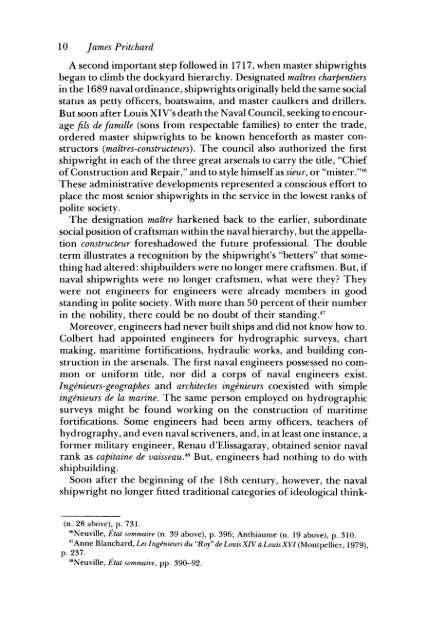Pritchard, James; From Shipwright To Naval Constructor - Iowa State ...
Pritchard, James; From Shipwright To Naval Constructor - Iowa State ...
Pritchard, James; From Shipwright To Naval Constructor - Iowa State ...
Create successful ePaper yourself
Turn your PDF publications into a flip-book with our unique Google optimized e-Paper software.
10 <strong>James</strong> <strong>Pritchard</strong><br />
A second important step followed in 1717, when master shipwrights<br />
began to climb the dockyard hierarchy. Designated mattres charpentiers<br />
in the 1689 naval ordinance, shipwrights originally held the same social<br />
status as petty officers, boatswains, and master caulkers and drillers.<br />
But soon after Louis XIV's death the <strong>Naval</strong> Council, seeking to encourage<br />
fils de famille (sons from respectable families) to enter the trade,<br />
ordered master shipwrights to be known henceforth as master constructors<br />
(mattres-constructeurs). The council also authorized the first<br />
shipwright in each of the three great arsenals to carry the title, "Chief<br />
of Construction and Repair," and to style himself as sieur, or "mister."46<br />
These administrative developments represented a conscious effort to<br />
place the most senior shipwrights in the service in the lowest ranks of<br />
polite society.<br />
The designation maitre harkened back to the earlier, subordinate<br />
social position of craftsman within the naval hierarchy, but the appellation<br />
constructeur foreshadowed the future professional. The double<br />
term illustrates a recognition by the shipwright's "betters" that something<br />
had altered: shipbuilders were no longer mere craftsmen. But, if<br />
naval shipwrights were no longer craftsmen, what were they? They<br />
were not engineers for engineers were already members in good<br />
standing in polite society. With more than 50 percent of their number<br />
in the nobility, there could be no doubt of their standing.47<br />
Moreover, engineers had never built ships and did not know how to.<br />
Colbert had appointed engineers for hydrographic surveys, chart<br />
making, maritime fortifications, hydraulic works, and building construction<br />
in the arsenals. The first naval engineers possessed no common<br />
or uniform title, nor did a corps of naval engineers exist.<br />
Ingenieurs-geographes and architectes ingenieurs coexisted with simple<br />
ingenieurs de la marine. The same person employed on hydrographic<br />
surveys might be found working on the construction of maritime<br />
fortifications. Some engineers had been army officers, teachers of<br />
hydrography, and even naval scriveners, and, in at least one instance, a<br />
former military engineer, Renau d'Elissagaray, obtained senior naval<br />
rank as capitaine de vaisseau.48 But, engineers had nothing to do with<br />
shipbuilding.<br />
Soon after the beginning of the 18th century, however, the naval<br />
shipwright no longer fitted traditional categories of ideological think-<br />
(n. 28 above), p. 731.<br />
46Neuville, Etat sommaire (n. 39 above), p. 396; Anthiaume (n. 19 above), p. 310.<br />
47Anne Blanchard, Les Ingenieurs du "Roy" de Louis XIV a Louis XVI (Montpellier, 1979),<br />
p. 237.<br />
48Neuville, Etat sommaire, pp. 390-92.


